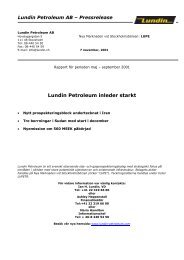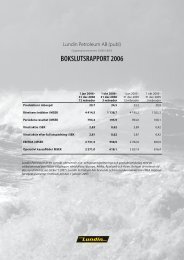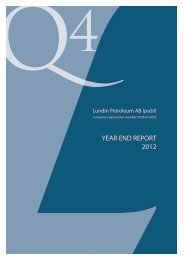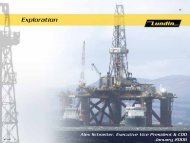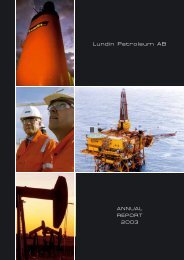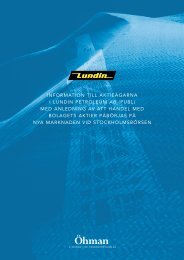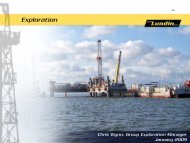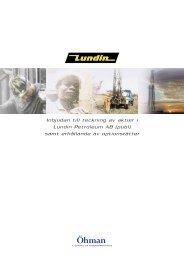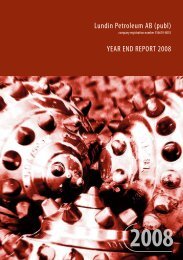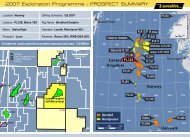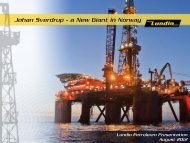Annual Report 2005 (6 MB) - Lundin Petroleum
Annual Report 2005 (6 MB) - Lundin Petroleum
Annual Report 2005 (6 MB) - Lundin Petroleum
You also want an ePaper? Increase the reach of your titles
YUMPU automatically turns print PDFs into web optimized ePapers that Google loves.
take a substantial period of time to get ready for their intended use<br />
or sale. Investment income earned on the temporary investment<br />
of specifi c borrowings pending to be used for the qualifying asset<br />
is deducted from the borrowing costs eligible for capitalisation.<br />
This applies on the interest on borrowings to fi nance fi elds under<br />
development which is capitalised within oil and gas properties<br />
until production commences. All other borrowing costs are<br />
recognised in profi t or loss in the period in which they occur.<br />
Interest on borrowings to fi nance the acquisition of producing oil<br />
and gas properties is charged to income as incurred.<br />
Leases<br />
For a lease to qualify as a fi nance lease, substantially all of the risks<br />
and benefi ts of ownership must pass to the lessee. In all other<br />
cases the lease will be classifi ed as an operating lease. Payments<br />
made under operating leases (net of any incentives received from<br />
the lessor) are charged to the income statement on a straight-line<br />
basis over the period of the lease.<br />
Employment benefi ts<br />
Short term employee benefi ts<br />
Short-term employment benefi ts such as salaries, social premiums<br />
and holiday pay, are expensed when incurred.<br />
Pension obligations<br />
Pensions are the most common long-term employee benefi t.<br />
The pension schemes are funded through payments to insurance<br />
companies. The Group’s pension obligations consist mainly of<br />
defi ned contribution plans. A defi ned contribution plan is a<br />
pension plan under which the Group pays fi xed contributions. The<br />
Group has no further payment obligations once the contributions<br />
have been paid. The contributions are recognised as an expense<br />
when they are due.<br />
The Group has one obligation under a defi ned benefi t plan. The<br />
relating liability recognised in the balance sheet is valued at the<br />
discounted estimated future cash outfl ows as calculated by an<br />
external actuarial expert. Actuarial gains and losses are charged to<br />
the income statement. The Group does not have any designated<br />
plan assets.<br />
Share-based payments<br />
<strong>Lundin</strong> <strong>Petroleum</strong> recognises cash-settled share-based payments<br />
in the income statement as expenses and as a liability in relation<br />
to the incentive warrants programme. The liability in relation to<br />
incentive warrants programmes is valued at fair value at grant date<br />
of the options using the Black & Scholes option pricing method.<br />
The fair value of the incentive warrant programme is charged<br />
to personnel costs over the vesting period. The fair value of the<br />
liability under the incentive warrant programme is remeasured at<br />
each reporting date recognising changes that aff ect the number<br />
of options expected to vest. At vesting date the liability is adjusted<br />
for the fi nal number of options vested.<br />
Income taxes<br />
The main components of tax are current and deferred. Current tax<br />
is tax that is to be paid or received for the year in question and<br />
> 55 <<br />
also includes adjustments of current tax attributable to previous<br />
periods.<br />
Deferred income tax is provided in full, using the liability method,<br />
on temporary diff erences arising between the tax bases of assets<br />
and liabilities and their carrying amounts in the consolidated<br />
fi nancial statements. However, the deferred income tax is not<br />
accounted for if it arises from initial recognition of an asset or<br />
liability in a transaction other than a business combination that at<br />
the time of the transaction aff ects neither accounting nor taxable<br />
profi t or loss. Deferred income tax is determined using tax rates<br />
(and laws) that have been enacted or substantially enacted by<br />
the balance sheet and are expected to apply when the related<br />
deferred income tax asset is realised or the deferred income tax<br />
liability is settled.<br />
Deferred income tax assets are recognised to the extent that it is<br />
probable that future taxable profi t will be available against which<br />
the temporary diff erences can be utilised.<br />
<strong>Lundin</strong> <strong>Petroleum</strong> divides the tax accounts between corporation<br />
tax and petroleum tax. <strong>Petroleum</strong> Revenue Tax (PRT) is classifi ed<br />
as <strong>Petroleum</strong> tax and charged as a tax expense on taxable fi eld<br />
profi ts included in the income statement.<br />
Segment reporting<br />
The primary basis the Group uses for segmental reporting is at a<br />
country level due to the unique nature of each countries operations,<br />
commercial terms or fi scal environment. The secondary basis the<br />
Group uses for segmental reporting is oil and gas operations for<br />
which reference is made to the fi nancial statements as a whole.<br />
Related party transactions<br />
<strong>Lundin</strong> <strong>Petroleum</strong> recognises the following related parties:<br />
associated companies, jointly controlled entities, members or the<br />
family of the key management personnel or other parties that are<br />
partly, direct or indirect, controlled by key management personnel<br />
or of its family.<br />
Critical accounting estimates and judgements<br />
The management of <strong>Lundin</strong> <strong>Petroleum</strong> has to make estimates<br />
and judgements when preparing the Financial Statements of the<br />
Group. Uncertainties in the estimates and judgements could have<br />
an impact on the carrying amount of assets and liabilities and the<br />
Group’s result. The most important estimates and judgements in<br />
relation thereto are:<br />
Estimates in oil and gas reserves<br />
The business of the Group is the exploration for, development<br />
of and production of oil and gas reserves. Estimates of oil and<br />
gas reserves are used in the calculations for impairment tests<br />
and accounting for depletion and site restoration. Changes in<br />
estimates in oil and gas reserves, resulting in diff erent future<br />
production profi les, will aff ect the discounted cash fl ows used in<br />
impairment testing, the anticipated date of site decommissioning<br />
and restoration and the depletion charges in accordance with the<br />
unit of production method.



